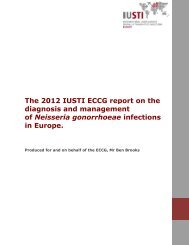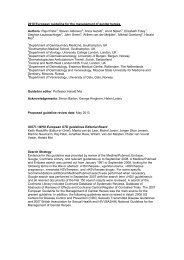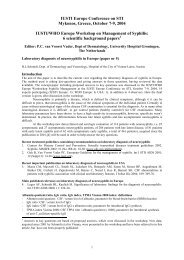Balanoposthitis - The International Union against Sexually ...
Balanoposthitis - The International Union against Sexually ...
Balanoposthitis - The International Union against Sexually ...
You also want an ePaper? Increase the reach of your titles
YUMPU automatically turns print PDFs into web optimized ePapers that Google loves.
70 <strong>International</strong> Journal of STD & AIDS Volume 12 Supplement 3 October 2001Management of partnersNot strictly necessary, although screening for otherSTI would be advisable. <strong>The</strong> patient should beinformed of the riskof transmission of HPV topartners) and barrier protection discussed.Follow-upAssess response to therapy at 1 month. Furtherfollow up only required if symptoms do notresolve, or other STI suspected.LICHEN SCLEROSUSDiagnosisClinical. Typical appearance: white plaques on theglans, often with involvement of the prepuce.<strong>The</strong>re may be haemorrhagic vesicles, andrarely blisters and ulceration. <strong>The</strong> prepucemay become phimotic, and the meatus may bethickened and narrowed.Laboratory. Biopsy: this initially shows a thickened epidermiswhich then becomes atrophic withfollicular hyperkeratosis. This overlies oedemaand loss of the elastin ®bres, with an underlyingperivascular lymphocytic in®ltrate.Biopsy is the de®nitive diagnostic procedure.ManagementIndications for therapy. Symptomatic balanoposthitis. Thickening of the skin on the glans or prepuce.Recommended regimens. Potent topical steroids 7 e.g. clobetasol proprionateor betamethasone valerate) appliedonce daily until remission, then graduallyreduced. Intermittent use e.g. once a week)may be required to maintain remission.Alternative regimensProcedures may be required for speci®c complications,but treatment of the underlying skin diseasewill still be required.. Circumcision if phimosis develops. Meatotomy for meatal stenosis.Management of partnersNot required.Follow upPatients requiring potent topical steroids fordisease control should be followed up regularly.<strong>The</strong> frequency of follow up will depend on thedisease activity and symptoms of the patient, butall patients should be reviewed by a doctor at leastannually in view of the small riskless than 1%) ofmalignant transformation 8 .In addition, patients should be advised to contactthe general practitioner or clinic if the appearancechanges.ZOON'S PLASMA CELL) BALANITISDiagnosisClinical. Typical appearance: well-circumscribedorange-red glazed areas on the glans withmultiple pin-point redder spots, `cayennepepper spots'. This may be similar to erythroplasiaof Queyrat, which is premalignant, andbiopsy is advisable. Patient usually over 30 years.Laboratory. Biopsy: epidermal atrophy, loss of rete ridges,lozenge keratinocytes and spongiosis, togetherwith a predominantly plasma cell in¯itratesubepidermally.ManagementIndications for therapy. Symptomatic balanitis.Recommended regimens. Topical steroid preparations, with or withoutadded antibacterial agents, e.g. Trimovateclobetasone butyrate, oxytetracycline andnystatin) cream, applied once or twice a day 9 .Alternative regimens. Circumcision: this has been reported to lead tothe resolution of lesions 10. CO 2 laser: this has been used to treatindividual lesions 11 Ð no clear evidence onequivalence.Management of partnersNot required.Follow up. Dependent on clinical course and treatmentused, especially if topical steroids are beingused long term. In cases of diagnostic uncertainty penilebiopsy should be performed prior to discontinuingfollow up, to exclude erythroplasia ofQueyrat.









